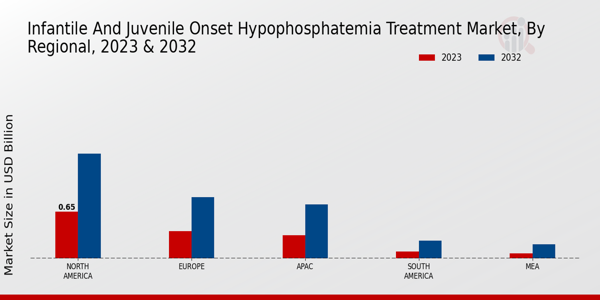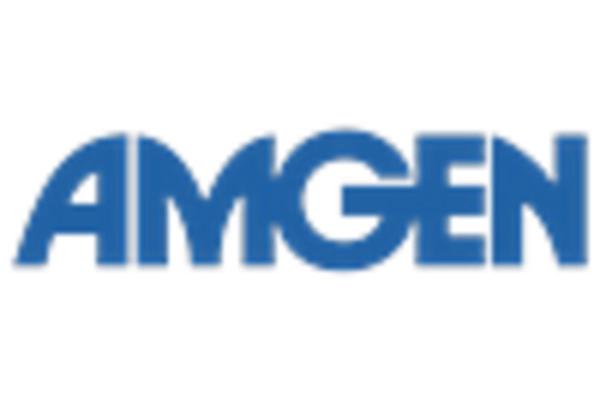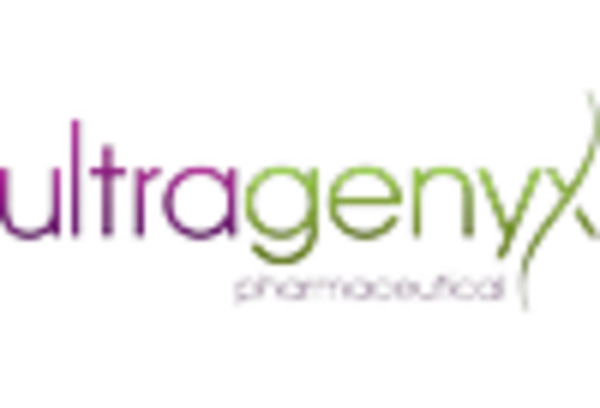Rising Healthcare Expenditure
The upward trend in healthcare expenditure is significantly influencing the Infantile and Juvenile Onset Hypophosphatemia Treatment Market. As countries continue to allocate more funds towards healthcare, there is a corresponding increase in the availability of advanced treatment options for various conditions, including hypophosphatemia. This rise in expenditure is facilitating better access to healthcare services, which is crucial for early diagnosis and effective management of the disease. Furthermore, with governments and private sectors investing in healthcare infrastructure, the market is likely to benefit from improved patient access to specialized treatments. This trend is expected to drive the demand for hypophosphatemia therapies, thereby contributing to the overall growth of the industry.
Innovative Treatment Modalities
The emergence of innovative treatment modalities is transforming the Infantile and Juvenile Onset Hypophosphatemia Treatment Market. Recent advancements in pharmacological therapies, including the development of new phosphate replacement therapies and the use of biologics, are providing more effective options for managing this condition. These innovations not only improve patient outcomes but also enhance the quality of life for affected individuals. The market is witnessing a shift towards more targeted therapies, which are designed to address the specific needs of patients with hypophosphatemia. As these novel treatments gain regulatory approval and enter the market, they are expected to significantly boost the overall growth of the industry.
Increasing Prevalence of Hypophosphatemia
The rising incidence of infantile and juvenile onset hypophosphatemia is a notable driver for the Infantile and Juvenile Onset Hypophosphatemia Treatment Market. Recent studies indicate that the prevalence of this condition is increasing, with estimates suggesting that it affects approximately 1 in 20,000 individuals. This growing patient population necessitates the development and availability of effective treatment options, thereby propelling market growth. As healthcare providers become more aware of the condition, the demand for specialized treatments is likely to rise. Furthermore, the increasing recognition of hypophosphatemia as a significant health issue among children is expected to lead to enhanced screening and diagnostic efforts, further contributing to the market's expansion.
Enhanced Awareness and Education Initiatives
Enhanced awareness and education initiatives regarding hypophosphatemia are playing a pivotal role in shaping the Infantile and Juvenile Onset Hypophosphatemia Treatment Market. Various organizations and healthcare providers are actively working to educate both the public and medical professionals about the signs, symptoms, and treatment options for this condition. Increased awareness is likely to lead to earlier diagnosis and treatment, which can significantly improve patient outcomes. Additionally, educational campaigns are fostering a better understanding of the importance of managing hypophosphatemia effectively. As awareness grows, the demand for specialized treatments is expected to rise, further propelling the market forward.
Growing Investment in Research and Development
The increasing investment in research and development (R&D) for hypophosphatemia treatments is a critical driver for the Infantile and Juvenile Onset Hypophosphatemia Treatment Market. Pharmaceutical companies are allocating substantial resources to explore new therapeutic options and improve existing treatments. This focus on R&D is likely to yield innovative solutions that address the unmet needs of patients suffering from this condition. According to industry reports, R&D spending in the field of rare diseases, including hypophosphatemia, has seen a marked increase, with projections indicating a compound annual growth rate of over 10% in the coming years. Such investments are expected to foster advancements in treatment efficacy and safety, thereby enhancing market growth.


















Leave a Comment